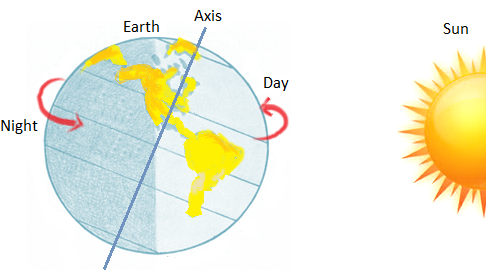Rotatory Motion of the Earth
We will discuss about the rotatory motion of the earth. Suppose, if we spin a top, it rotates around its pointed end. Just like the top, our earth moves all the time spinning on its own axis, from west to east.
The imaginary line passes through the north and south poles of the Earth is called the axis of rotation. This spinning movement of the Earth is called rotation. The earth completes one rotation on its axis in about 24 hours (i.e. one day and one night).
Due to its spherical shape, half of its spherical area gets light from the sun and the other half remains in the dark. For about 12 hours one half area of the earth is lighted while the other half remains dark during the same period. We say there is day in half of the sphere for about 12 hours and in the same period there is night in the other half. The next twelve hours, the position would be reversed, i.e. there will be night in the first half and day time in the second. Days are warmer while nights are cooler.
As the earth rotates from west to east, the sun seems to rise in the east and set in the west. At noon when the sun comes over our head, it gets too hot while in morning and evening we do not feel so hot. Thus, daily rotation of the earth affects the weather.
From Rotatory Motion of the Earth to HOME PAGE
Recent Articles
-
What Is Plasma? | Blood Plasma | Proteins | Nutrients | Cholesterol
Nov 07, 25 10:29 AM
Blood is a mobile fluid which is a connective tissue and is derived from the mesoderm like cell any other connective tissue. Colour of blood is reddish and that flows inside the blood vessels by means… -
Disorders of Respiratory System | Tuberculosis | Pleurisy | Emphysema
Oct 28, 25 11:39 PM
Tuberculosis is very common disease and is caused by a type of bacteria called Mycobacterium tuberculosis. This disease causes different trouble in the respiration and infection of several parts of th… -
Regulation of Respiration | Respiratory Centres | Inspiratory Area |
Oct 14, 25 12:13 AM
Respiratory Centre is the area that controls the rate of respiration and it is observed to be located in medulla oblongata and pons. Respiratory Centre has the following will dispersed components like… -
Explain Transport of Gases | External Respiration | Tissue Respiration
Oct 09, 25 11:35 PM
In humans gaseous exchange is completed in the following ways the steps are - External Respiration or Breathing - Breathing in false taking in of Oxygen and giving out of carbon dioxide in the body. M… -
Kind and Number of Teeth | Location of Teeth in Mouth | Care of Teeth
Sep 11, 25 12:52 AM
Kind and Number of Teeth






New! Comments
Have your say about what you just read! Leave me a comment in the box below.